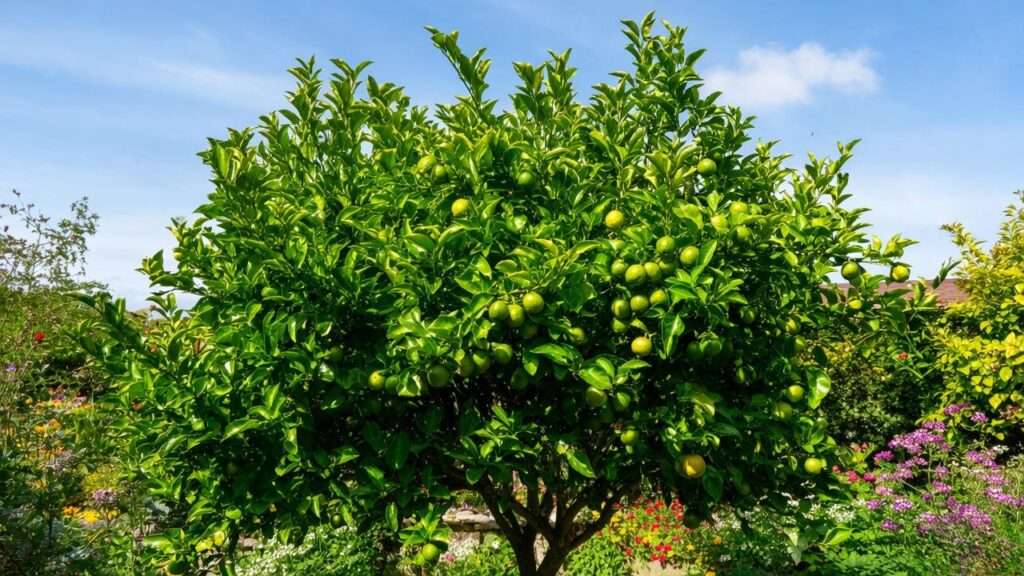Imagine plucking vibrant, tangy limes from your very own bush lime tree, ready to zest up your favorite dishes or cool drinks! 🌞 Whether you’re a novice gardener or a seasoned green thumb, growing a healthy bush lime tree (Citrus aurantifolia) is a rewarding journey that brings fresh flavor and lush greenery to your home. This comprehensive guide delivers expert-driven, actionable advice to ensure your lime tree thrives, addressing every aspect of care from planting to harvest. Backed by horticultural science and real-world experience, we’ll help you overcome common challenges and achieve bountiful harvests. Let’s dive into the world of citrus care and make your bush lime tree a star in your garden! 🌟
1. Understanding the Bush Lime Tree 🌱
1.1 What Is a Bush Lime Tree?
The bush lime tree, scientifically known as Citrus aurantifolia, is a compact, evergreen citrus variety prized for its tart, juicy limes. Often referred to as the Key lime or Mexican lime, this tree typically grows 6–13 feet tall but can be maintained smaller in containers, making it ideal for patios, small gardens, or even indoor spaces. Its glossy green leaves, fragrant white blossoms, and small, round limes add both aesthetic and culinary value. Unlike larger citrus trees like oranges or lemons, the bush lime’s dwarf nature makes it a versatile choice for home growers.
1.2 Benefits of Growing a Bush Lime Tree
Why choose a bush lime tree? Beyond the joy of homegrown limes, these trees offer multiple benefits:
- Culinary Versatility: Limes enhance recipes like ceviche, guacamole, mojitos, and key lime pie. 🍹
- Aesthetic Appeal: Their lush foliage and vibrant fruit elevate any garden or patio.
- Environmental Impact: They attract pollinators like bees, supporting local ecosystems. 🐝
- Cost Savings: Growing your own limes reduces grocery bills and ensures organic, pesticide-free fruit.
1.3 Ideal Growing Zones and Conditions
Bush lime trees thrive in USDA hardiness zones 9–11, where temperatures rarely dip below 25°F (-4°C). They love warm, sunny climates with at least 6–8 hours of direct sunlight daily. If you live in cooler regions, don’t worry—you can grow them in containers and move them indoors during winter. Frost is their enemy, so protection is key in borderline zones. For optimal growth, ensure well-draining soil and moderate humidity, mimicking their native tropical environments.
2. Planting Your Bush Lime Tree 🌳
2.1 Choosing the Right Tree
Selecting a healthy bush lime tree is the foundation of success. Visit a reputable nursery or trusted online retailer and look for:
- Vibrant Foliage: Bright green, glossy leaves with no yellowing or spots.
- Strong Structure: A sturdy trunk and well-distributed branches.
- Root Health: If potted, ensure roots aren’t circling tightly (root-bound).
Opt for grafted trees for faster fruiting and disease resistance, though non-grafted trees can work for patient gardeners. Popular varieties include the Key lime (small, tart fruit) and Bearss lime (larger, seedless limes).
2.2 Soil and Site Preparation
Bush lime trees demand well-draining, slightly acidic soil (pH 6.0–7.0). Test your soil with a pH kit and amend with sulfur or lime if needed. For in-ground planting:
- Choose a sunny, wind-sheltered spot.
- Dig a hole twice as wide and deep as the root ball.
- Mix in organic compost to boost nutrients.
For container gardening, select a pot at least 12–16 inches in diameter with drainage holes. Use a citrus-specific potting mix or blend peat moss, perlite, and compost for optimal drainage. 🪴
2.3 Step-by-Step Planting Guide
- Timing: Plant in spring or early fall for optimal root establishment.
- Prepare the Site: Clear weeds and amend soil as needed.
- Planting: Place the tree at the same depth as it was in its nursery pot. Backfill with soil, tamp gently, and water thoroughly.
- Container Tips: Ensure pots have drainage trays and elevate slightly to prevent root rot.
- Expert Tip: Mulch with bark or wood chips (2–3 inches thick) to retain moisture and deter weeds, keeping mulch 2 inches from the trunk. 🌾
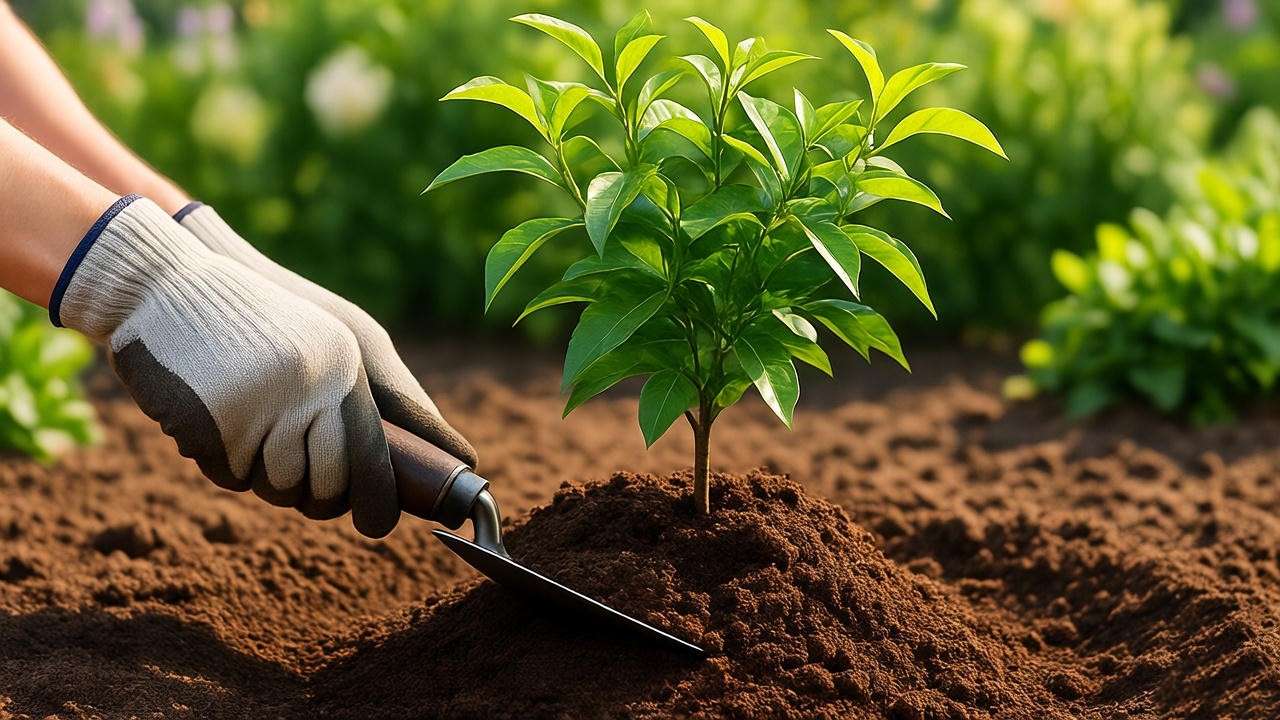
3. Essential Care Tips for a Thriving Bush Lime Tree 🌞
3.1 Watering Requirements
Consistent watering is critical, but overwatering can harm your bush lime tree. Aim for:
- Frequency: Water deeply every 5–7 days for in-ground trees, or when the top 2 inches of soil feel dry for potted trees.
- Amount: Provide 1–2 gallons for young trees, increasing as they grow.
- Signs to Watch: Yellowing leaves may indicate overwatering, while wilting suggests underwatering. 🚿
Use drip irrigation or a soaker hose for even moisture, and avoid wetting foliage to prevent fungal issues.
3.2 Fertilizing for Optimal Growth
Bush lime trees are nutrient-hungry. Use a balanced citrus fertilizer (e.g., 10-10-10 or 8-8-8) with micronutrients like magnesium and zinc. Fertilize:
- Spring to Summer: Every 6–8 weeks during the growing season.
- Fall to Winter: Reduce to every 10–12 weeks.
- Organic Options: Compost tea or fish emulsion for eco-conscious gardeners.
Always water after fertilizing to prevent root burn. Over-fertilizing can cause leaf drop, so follow package instructions carefully.
3.3 Pruning and Shaping
Pruning keeps your bush lime tree healthy and productive. Prune in late winter or early spring before new growth begins:
- Remove: Dead, damaged, or crossing branches to improve airflow.
- Shape: Trim to maintain a compact, open canopy for sunlight penetration.
- Tools: Use clean, sharp pruning shears to avoid disease spread. ✂️
For container trees, prune lightly to control size. Regular pruning encourages fruit production and prevents pest issues.

3.4 Sunlight and Temperature Needs
Bush lime trees crave sunlight—6–8 hours daily is non-negotiable. Place potted trees near south-facing windows indoors or on sunny patios. Protect from:
- Extreme Heat: Use shade cloths during scorching summers (above 100°F/38°C).
- Cold Snaps: Cover with frost blankets or move indoors if temperatures drop below 30°F (-1°C). ❄️
- Expert Insight: Rotate potted trees every few weeks to ensure even light exposure.
4. Protecting Your Bush Lime Tree from Pests and Diseases 🐞
4.1 Common Pests
Bush lime trees attract pests like:
- Citrus Leaf Miners: Cause wavy trails on leaves. Control with neem oil sprays.
- Aphids: Suck sap and stunt growth. Rinse off with water or use insecticidal soap.
- Scale Insects: Appear as small bumps on stems. Scrape off and apply horticultural oil.
Regularly inspect leaves and stems, and introduce beneficial insects like ladybugs to keep pests in check. 🦋
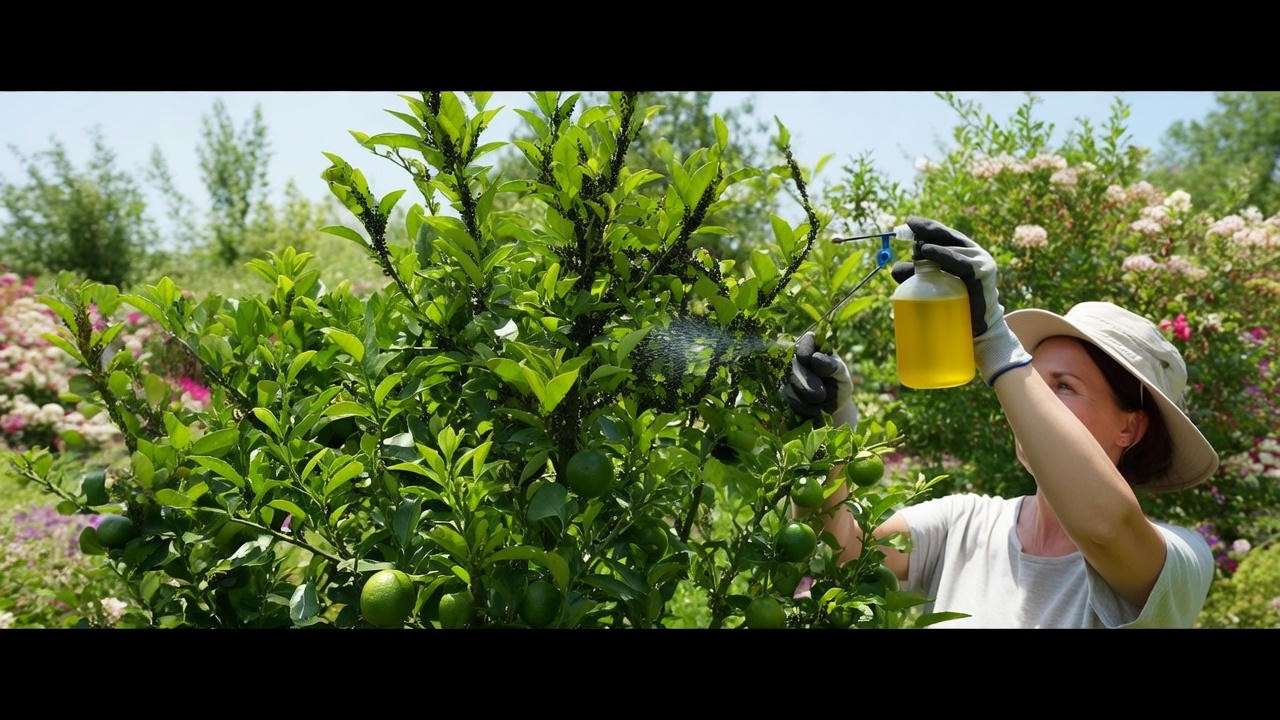
4.2 Common Diseases
Watch for these threats:
- Citrus Greening: Causes yellowing leaves and bitter fruit. No cure—remove infected trees to prevent spread.
- Root Rot: From overwatering or poor drainage. Ensure proper soil and drainage.
- Anthracnose: Fungal spots on leaves. Treat with copper-based fungicides.
Sanitize tools with a 10% bleach solution between cuts to prevent disease spread. 🧼
4.3 Expert Tips for Disease Prevention
- Space trees to ensure airflow and reduce humidity.
- Avoid overhead watering to keep foliage dry.
- Case Study: A Florida gardener saved their lime tree by improving drainage and using organic mulch, preventing root rot recurrence.
5. Harvesting and Using Your Limes 🍈
5.1 When and How to Harvest
Harvesting limes at the right time ensures the best flavor and quality. Look for these signs of ripeness:
- Color: Limes turn from green to yellow-green or fully yellow (though green limes are often harvested for their tartness).
- Size: Typically 1.5–2 inches in diameter, depending on the variety.
- Firmness: Fruit should feel firm but yield slightly to gentle pressure.
To harvest, use clean pruning shears or twist limes gently to avoid damaging branches. Most bush lime trees produce fruit year-round in warm climates, with peak harvests in summer and fall. Expect 1–3 years for a young tree to bear fruit, with mature trees yielding 50–100 limes annually under optimal conditions.
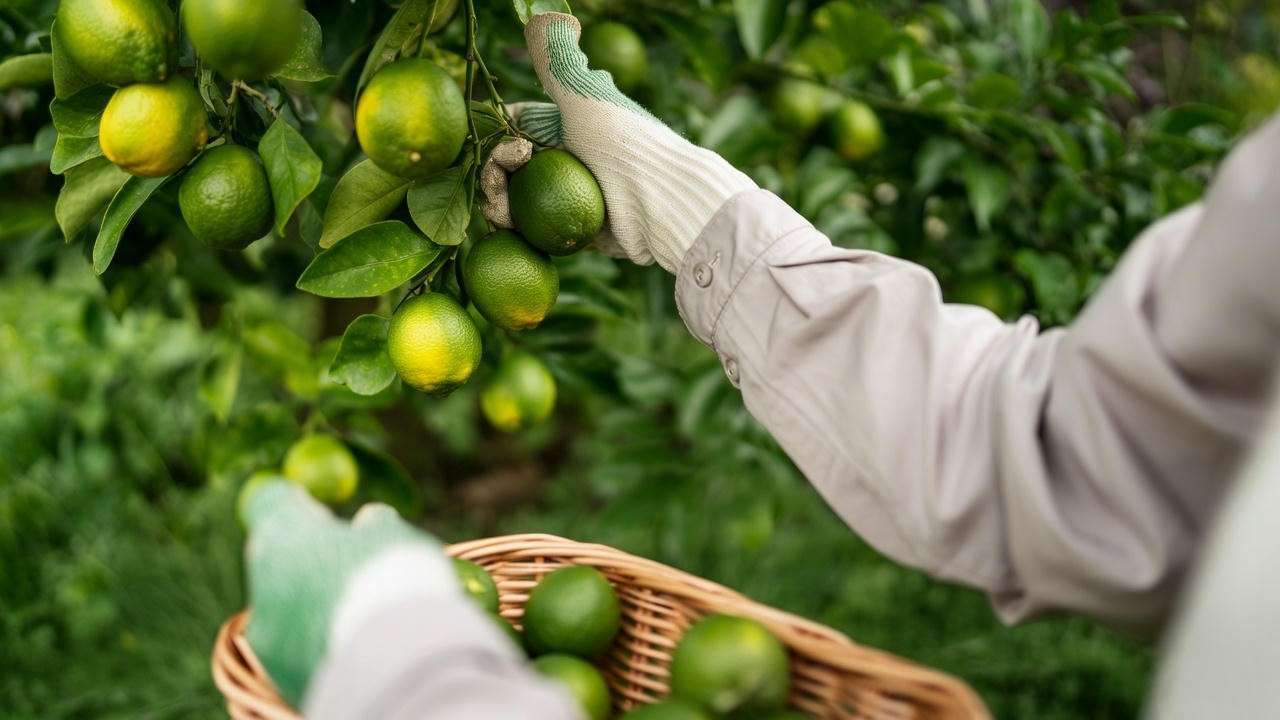
5.2 Storing and Preserving Limes
Fresh limes can last up to a month if stored properly:
- Refrigeration: Place limes in a perforated plastic bag in the fridge’s crisper drawer (35–40°F/2–4°C).
- Room Temperature: Store for up to a week in a cool, dry place.
- Preservation Methods:
- Freeze lime juice in ice cube trays for easy use in recipes. 🧊
- Dry lime zest for seasoning or baking.
- Make lime preserves or marmalade for long-term storage. 🍯
Expert Tip: Save lime leaves for teas or as a flavoring agent in soups and curries—they’re packed with citrusy aroma!
5.3 Culinary and Non-Culinary Uses
Limes are incredibly versatile:
- Culinary Uses:
- Add zest or juice to dishes like tacos, ceviche, or salad dressings.
- Create refreshing drinks like mojitos, limeade, or margaritas. 🍹
- Bake classics like key lime pie or lime-infused cakes. 🥧
- Non-Culinary Uses:
- Use lime juice as a natural cleaner for cutting boards or stainless steel.
- Incorporate lime essential oil in aromatherapy for a calming effect.
- Mix lime juice with honey for a soothing face mask.
Fun Fact: Limes were historically used by sailors to prevent scurvy, earning them the nickname “limeys” in the 18th century.
6. Troubleshooting Common Problems 🔧
6.1 Why Isn’t My Bush Lime Tree Fruiting?
If your tree isn’t producing limes, consider these culprits:
- Young Age: Trees under 2–3 years may not yet be mature enough to fruit.
- Nutrient Deficiency: Lack of nitrogen or micronutrients like zinc can halt flowering. Apply a citrus-specific fertilizer.
- Poor Pollination: Encourage bees by planting pollinator-friendly flowers nearby or hand-pollinate with a small brush. 🐝
- Stress: Overwatering, underwatering, or extreme temperatures can prevent fruiting.
Solution: Adjust care routines, ensure consistent watering, and be patient—healthy trees will fruit with time.
6.2 Yellowing Leaves and Other Warning Signs
Yellow leaves are a common issue with multiple causes:
- Overwatering: Check soil drainage and reduce watering frequency.
- Nutrient Deficiency: Test soil and apply a balanced fertilizer if nitrogen or magnesium is low.
- Pests or Disease: Inspect for leaf miners or fungal spots and treat promptly.
Troubleshooting Guide:
- Assess watering habits and improve drainage if needed.
- Test soil pH and nutrient levels with a home kit.
- Inspect leaves and stems for pests or disease symptoms.
- Consult a local extension service if issues persist.
6.3 Container-Specific Challenges
Potted bush lime trees face unique issues:
- Root-Bound Trees: Roots circling the pot indicate it’s time to repot. Choose a pot 2–4 inches larger and refresh the soil.
- Indoor Challenges: Low humidity or insufficient light can stunt growth. Use a grow light and a pebble tray for humidity. 💡
- Tip: Repot every 2–3 years to refresh soil nutrients and promote healthy root growth. 🌱
7. Advanced Tips for Maximizing Your Harvest 🚀
7.1 Grafting for Improved Yields
Grafting involves attaching a cutting from a productive lime tree to a hardy rootstock. Benefits include:
- Faster fruiting (as early as 1–2 years).
- Increased disease resistance (e.g., to citrus greening).
- Enhanced fruit quality and yield.
Basic Grafting Steps:
- Select a healthy scion (cutting) from a productive lime tree.
- Use a compatible rootstock (e.g., trifoliate orange).
- Make a clean cut and join the scion to the rootstock with grafting tape.
- Monitor for successful union over 4–6 weeks.
Consult a local horticulturist for hands-on guidance, as grafting requires precision.
7.2 Companion Planting
Companion plants enhance your bush lime tree’s health:
- Marigolds: Deter aphids and nematodes with their strong scent.
- Basil: Repels pests and attracts pollinators.
- Nasturtiums: Act as a trap crop for aphids, protecting your lime tree.
Example Layout: Plant marigolds around the base of an in-ground tree or in nearby pots for container gardens. Space companions 12–18 inches from the trunk to avoid competition. 🌼
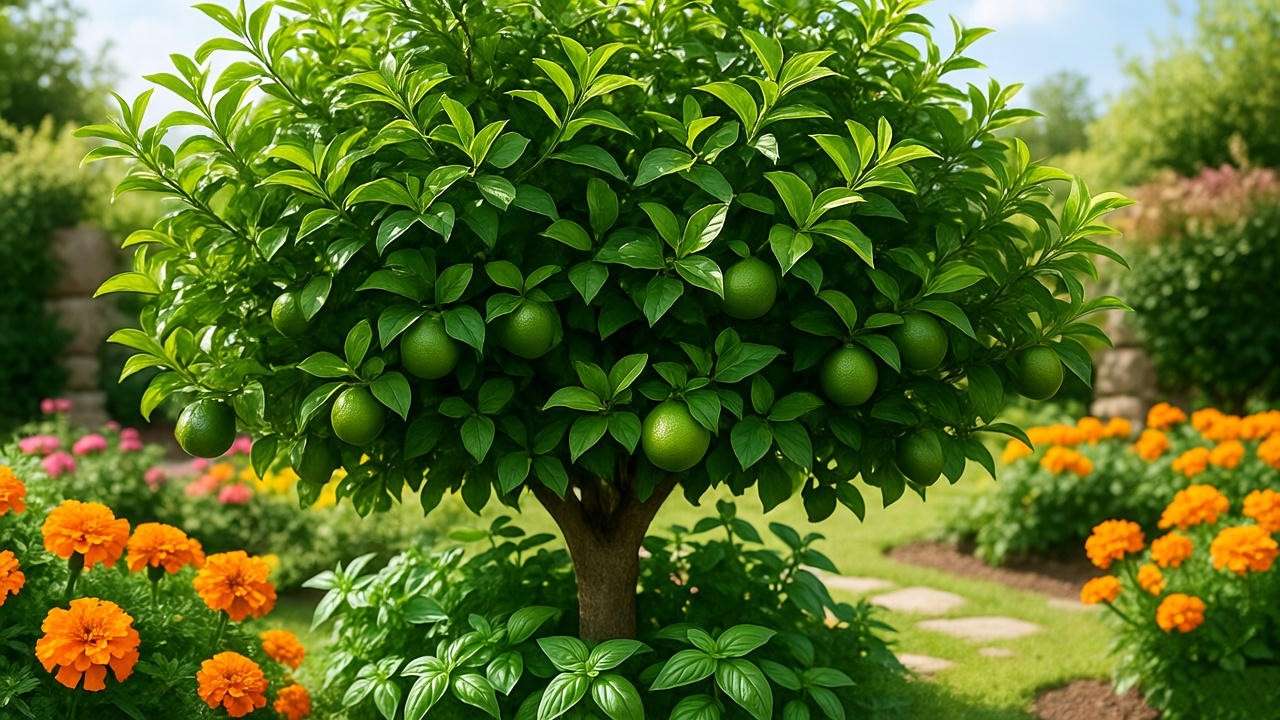
7.3 Sustainable Practices
Eco-friendly care benefits both your tree and the environment:
- Water Conservation: Use drip irrigation or collect rainwater to reduce waste.
- Organic Gardening: Opt for compost, worm castings, or fish emulsion instead of synthetic fertilizers.
- Mulching: Apply 2–3 inches of organic mulch (e.g., bark or straw) to retain moisture and suppress weeds.
Expert Quote: “Sustainable citrus care not only ensures healthy trees but also preserves our ecosystems for future generations,” says Dr. Jane Carter, a citrus horticulturist with 20 years of experience.
8. FAQs About Bush Lime Tree Care ❓
- Q1: How long does it take for a bush lime tree to bear fruit?
A: Typically 1–3 years, depending on tree age, variety, and care. Grafted trees fruit faster than seed-grown ones. - Q2: Can I grow a bush lime tree indoors year-round?
A: Yes, with 6–8 hours of sunlight (or grow lights), proper humidity, and regular care. Choose a dwarf variety for easier management. - Q3: What’s the best fertilizer for a bush lime tree?
A: A balanced citrus fertilizer (e.g., 10-10-10) with micronutrients, applied every 6–8 weeks during the growing season. - Q4: How do I protect my lime tree from frost?
A: Use frost blankets, move potted trees indoors, or wrap trunks with burlap in temperatures below 30°F (-1°C). - Q5: Why are my limes small or dropping prematurely?
A: Possible causes include water stress, nutrient deficiencies, or pests. Ensure consistent care and inspect for issues.
9. Conclusion
Growing a thriving bush lime tree is within your reach with the right knowledge and care. From selecting a healthy sapling to mastering watering, fertilizing, and pest control, this guide equips you with everything needed for success. Whether you’re dreaming of fresh limes for your next mojito or a lush patio centerpiece, your bush lime tree will reward your efforts with beauty and bounty. 🌟 Start your citrus journey today, and share your success stories in the comments below! Try our lime-based recipes or experiment with sustainable practices to make your garden shine. With patience and care, your bush lime tree will thrive for years to come.

